An Updated Taste of Old Cuzco: Sabores Cusqueños

“What is most important to me is that diners come away happy from eating tasty food,” explained Mr. Eudocio Velasquez, the proprietor of the Sabores Cusqueños Restaurant, whose name means “flavors of Cuzco.” Many places hope to serve good food, but Sabores Cusqueños is more than good food, it is also a traditional yet innovative and charming place.
The first thing drawing you to this restaurant is a large mural on its streetside wall where the dancers in costume perfor the contradanza in devotion to the Mamacha Carmen, as the Virgin of Carmen is called. Typical of the regional town of Paucartambo in Cuzco this dance is performed by devotees of the Virgin as an act of faith at the same time it maintains important indigenous traditions.
The mural, painted by students from Cusco’s School of Fine Arts (Bellas Artes), although Mr. Velasquez says he designed it, also contains a table with images of traditional Cuzco-style cooking and food on it.
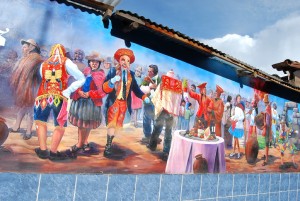
The quality of the mural and its attractiveness on a fairly ordinary urban street in Cuzco just outside the Colonial Core signals the care and devotion Mr. Velasquez and his family dedicate tot heir restaurant.
Inside the tables are in an open aired patio filled with plants and decorative items, suggesting old Cuzco homes with their extensive patios that were key to family life. To the side of the patio, shielded only by bushes, flowers, and pear trees, is an open aired kitchen where one can watch the food’s preparation as a kind of shadow play, with occasional eruptions of fire, among the leaves and blooms.


Mr. Velasquez himself, a warm faced man with poise and knowledge brought our menus to us and responded to my questions about how they came to open a restaurant. It was evident almost from first word that Mr. Velasquez was from Cuzco’s professional classes with substantial higher education, though such things remained in the background, filtering through everything else.
He spoke of his love for food, care in cooking, and creativity. Such was evident in the menu, where classic Cuzco dishes, such as pan sauteed chicken breast was accompanied by what he called a potato soufflé, rather than the traditional french fries or the pan-fried trout which had a crisp potato lattice under it rather than, again, the seemingly unavoidable french fries.
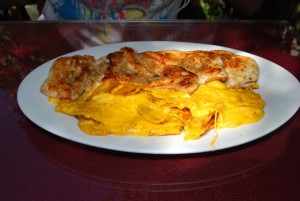
Instead of changing the subject to his ample professional accomplishments, Mr Velasquez smiled and discussed is own hobby of fine art when asked about the mural. He etched local designs into glass, he said, as a hobby. He had a framed mirror brought on which he had skillfully etched a pietá, and then another with a rendering of Machu Picchu.
“I don’t sell my works” he insisted, “although if someone wants to buy them I also will not say no.”
Around that time large bowls of soup arrived. it was a kind of cream of potato made from the seasonal papa helada, once frozen potatoes and had within it small, delicately flavored moraya–white freeze dried potatoes that had been reconstituted and cooked.
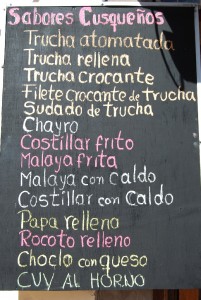
Some restaurants are all about personality, but with the soup we knew that Sabores Cusqueños was not only about color and style, but even more about the food.
The first taste brought not only the creaminess of a good potato soup, but almost a sigh from the depth of flavor from the outstanding broth with which it was made. Seldom do soups have such depth of flavor
Mr. Velazquez could hardly contain a small smile at our pleasure in those first spoonfuls of soup, and we still had the main course before us.
Soon our plates arrived. Yimpol, our driver for the afternoon, had ordered mutton ribs, (costillar), Walter panfried trout, Hebert a breaded beef cutlet (churrasco apanado) and I a filleted and sautéed chicken breast.
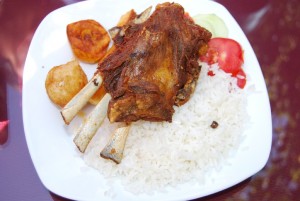
When I cut into the chicken breast, I was surprised. It was crispy on the outside from contact with the hot pan, but the inside was moist, It was perfectly cooked with no red and yet not even over-cooked by one second. A matter of attention to detail and timing, it is not that hard to accomplish and yet seldom is. Generally, for the chicken to be crisp the inside ends up dry in most restaurants I have tried.
The soufflé was not what that French word suggests. Instead it was a gratin of lightly pre-fried potatoes in a white sauce to which cheese and yellow ají had been added. (While it is possible this could have been turmeric–colorante–since that also produces the mustard color of the gratin, given the flavor I am sure it was yellow aji or a combination fo the two.)
Similar quality and attention to detail was evident in each of the other dishes, with the only exception being the trout. While delicious it had not been well boned. Otherwise each of the meats was perfectly flavored and perfectly cooked.
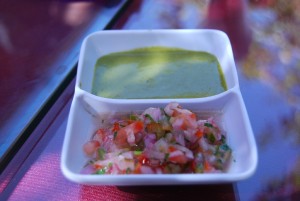
Mr. Velasquez’ kitchen was both traditional, in the meats and styles of preparation, but also creative in the sides offered, bound to Cuzco’s historical ways and yet innovative and up-dated.
In this way, Mr. Velasquez told us of his devotion to the Mamacha. He is from Paucartambo, an historic town near where they Incas are said to have originated in Tambo Tocto, which is famous fro its great feast of the Virgin of Carmen and for its traditional contradanza.
Though he dances every year for the Virgin and has for decades, Mr. Velazquez does not return to Paucartambo to do so. He smiles and says that his family and friends there consider him a bit of a renegade, since he participates in the brotherhood of dancers of the city of Pisaq which is closer to Cuzco.
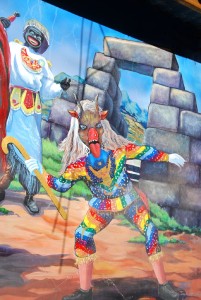
Sabores Cusqueños, Jiron Pumacahua #29, is worth a visit both for its wonderful food as well as for the rustic charm of its locale. In it one sees the pride many Cusqueños have in their region and its culture; they do not slavishly reproduce it but constantly update it all the while keeping it vital and alive. As a result, here you find the idea of a traditional picantería that honors both tradition and innovation. Diners here will enjoy themselves and go away happy.




